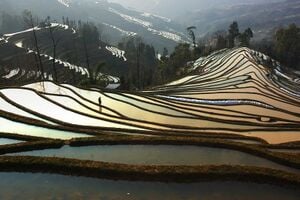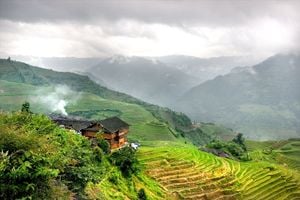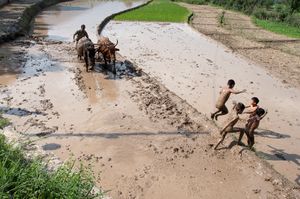No edit summary |
No edit summary |
||
| Line 1: | Line 1: | ||
{{JMC330inprogress|May 15, 2012}} | {{JMC330inprogress|May 15, 2012}} | ||
''' | The construction of '''Rice Terraces''' date back to ancient times. This method of growing rice has allowed farmers to cultivate sloped, hilly and mountainous land. Modern rice growers may prefer the use of advanced mechanic tools, but in most developing countries, the act of growing rice remains labor intensive— done without the aid of machinery. Not only are they aesthetically pleasing, rice terraces carry many benefits that help preserve land, soil, small ecosystems and weaken human’s reliance on heavy machinery. | ||
[[Image:Riceterrace.jpg|thumb|right|Rice terrace in Honghe Prefecture in China's Yunnan province]] | |||
== Suitable Land == | |||
Rice terraces are mostly found in east, south and southeast Asia. The ideal location for a rice terrace should include these qualities: slight sloped curve on land, a reliable year round water source and close proximity to building materials such as gravel, topsoil and stones. | |||
== How it works == | |||
[[Image:Flickr-248273432-hd.jpg|thumb|left|Rice Terrace in Longsheng near Guilin, China]] | |||
Water supply, the most important aspect of rice terraces, is provided from rivers and mountain streams; irrigation flows through the same complex canals and river ways that are centuries old. The different levels of rice terraces allow water to flow successively down each level. | |||
A seed is first planted on a seedbed, after a couple of weeks, the seed is transplanted to rice terraces filled with six inches of water, otherwise known as paddies. This technique gives the slightly more mature seed a head start over any competing weeds. As the seed matures, the water levels in the paddies decrease— by full maturity, the grounds should be completely dry, allowing for an easy harvest. | |||
== Building Process == | |||
The construction of rice terraces is not an easy task and require constant maintenance, yet the same method has been passed on for many centuries. Rice terraces built centuries go are still being utilized today— speaking volumes to their effectiveness even in modern society. | |||
After choosing an ideal location, a pond where water will be retained should be constructed on the highest point of the terrace. | After choosing an ideal location, a pond where water will be retained should be constructed on the highest point of the terrace. | ||
Builders then lay down marking stones that act as the foundation for retaining walls that help keep the terraces in tact. Since this technique alters the natural state of the earth, multiple layers of retaining walls | Builders then lay down marking stones that act as the foundation for retaining walls that help keep the terraces in tact. Since this technique alters the natural state of the earth, multiple layers of retaining walls backed with gravel support needs to be constructed. | ||
Next, eight to ten inches of earth and topsoil are transported to the newly constructed rice terraces. The soil is then stomped and smoothed to create a flat surface suitable for agriculture. | Next, eight to ten inches of earth and topsoil are transported to the newly constructed rice terraces. The soil is then stomped and smoothed to create a flat surface suitable for agriculture. | ||
| Line 18: | Line 32: | ||
Flooding the land with water marks the completion of a rice terrace. | Flooding the land with water marks the completion of a rice terrace. | ||
== Benefits == | |||
[[Image:Childrenricepaddie.jpg|thumb|right|Planting on rice paddies]] | |||
Rice terraces benefit the environment and its inhabitants. Their construction allows for farmers to sow and harvest land otherwise not suitable for farming. | |||
Environmental benefits include; soil conservation by decreasing erosion and rapid surface runoff, and flood control by letting rainwater seep underground before it slowly flows out into bodies of water. | Environmental benefits include; soil conservation by decreasing erosion and rapid surface runoff, and flood control by letting rainwater seep underground before it slowly flows out into large bodies of water. | ||
The terraces also help relax mankind’s reliance on heavy machinery, some of which are not available in many developing countries. The fields are a step to filter water and house small ecosystems containing insects or frogs. | The terraces also help relax mankind’s reliance on heavy machinery, some of which are not available in many developing countries. The fields are a step to filter water and house small ecosystems containing insects or frogs. | ||
== External Links == | |||
[http://www.bicing.com Bicing] | |||
[http://www.bicing.com/pfw_files/cma/modulos/bicing_mapa_nov.jpg Map of Bicing Stations] | |||
[http://www.youtube.com/watch?v=lCNboaWtqIc Youtube video on Bicing] | |||
[http://itunes.apple.com/WebObjects/MZStore.woa/wa/viewSoftware?id=296701552&mt=8 iPhone Bicing Application] | |||
[[Category:JMC330 International Mass Communication]] | |||
[[Category:Agriculture]] | |||
[[Category:Farming]] | |||
[[Category:Water]] | |||
[[Category:Rice]] | |||
[[Category:Sustainability]] | |||
[[Category:JMC330 International Mass Communication]] | [[Category:JMC330 International Mass Communication]] | ||
Revision as of 15:49, 27 March 2012
The construction of Rice Terraces date back to ancient times. This method of growing rice has allowed farmers to cultivate sloped, hilly and mountainous land. Modern rice growers may prefer the use of advanced mechanic tools, but in most developing countries, the act of growing rice remains labor intensive— done without the aid of machinery. Not only are they aesthetically pleasing, rice terraces carry many benefits that help preserve land, soil, small ecosystems and weaken human’s reliance on heavy machinery.

Suitable Land
Rice terraces are mostly found in east, south and southeast Asia. The ideal location for a rice terrace should include these qualities: slight sloped curve on land, a reliable year round water source and close proximity to building materials such as gravel, topsoil and stones.
How it works

Water supply, the most important aspect of rice terraces, is provided from rivers and mountain streams; irrigation flows through the same complex canals and river ways that are centuries old. The different levels of rice terraces allow water to flow successively down each level.
A seed is first planted on a seedbed, after a couple of weeks, the seed is transplanted to rice terraces filled with six inches of water, otherwise known as paddies. This technique gives the slightly more mature seed a head start over any competing weeds. As the seed matures, the water levels in the paddies decrease— by full maturity, the grounds should be completely dry, allowing for an easy harvest.
Building Process
The construction of rice terraces is not an easy task and require constant maintenance, yet the same method has been passed on for many centuries. Rice terraces built centuries go are still being utilized today— speaking volumes to their effectiveness even in modern society.
After choosing an ideal location, a pond where water will be retained should be constructed on the highest point of the terrace.
Builders then lay down marking stones that act as the foundation for retaining walls that help keep the terraces in tact. Since this technique alters the natural state of the earth, multiple layers of retaining walls backed with gravel support needs to be constructed.
Next, eight to ten inches of earth and topsoil are transported to the newly constructed rice terraces. The soil is then stomped and smoothed to create a flat surface suitable for agriculture.
Flooding the land with water marks the completion of a rice terrace.
Benefits

Rice terraces benefit the environment and its inhabitants. Their construction allows for farmers to sow and harvest land otherwise not suitable for farming.
Environmental benefits include; soil conservation by decreasing erosion and rapid surface runoff, and flood control by letting rainwater seep underground before it slowly flows out into large bodies of water.
The terraces also help relax mankind’s reliance on heavy machinery, some of which are not available in many developing countries. The fields are a step to filter water and house small ecosystems containing insects or frogs.